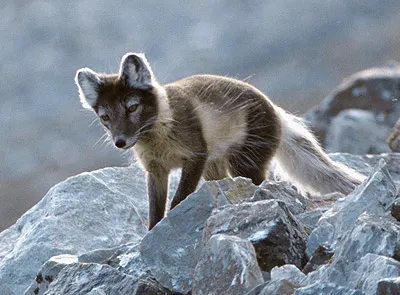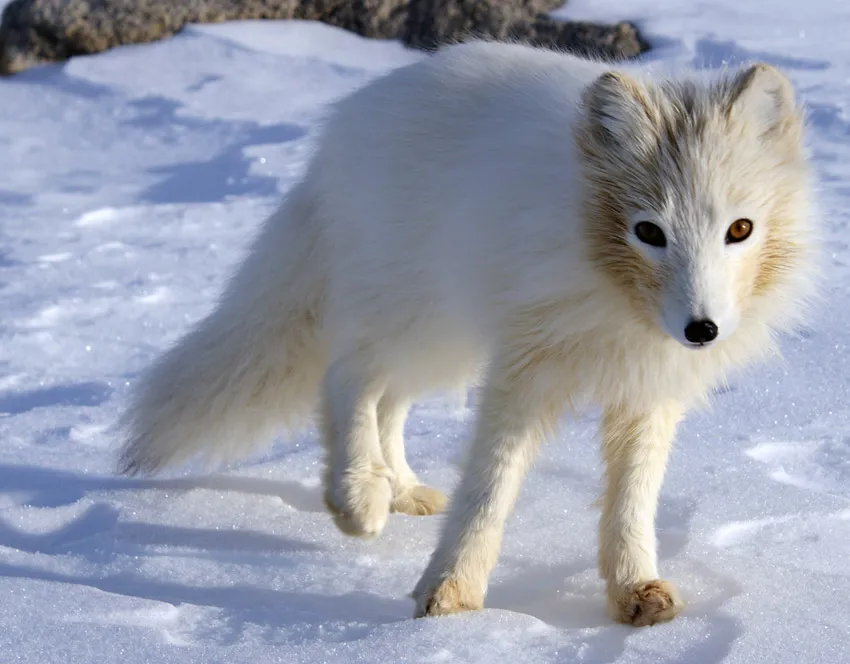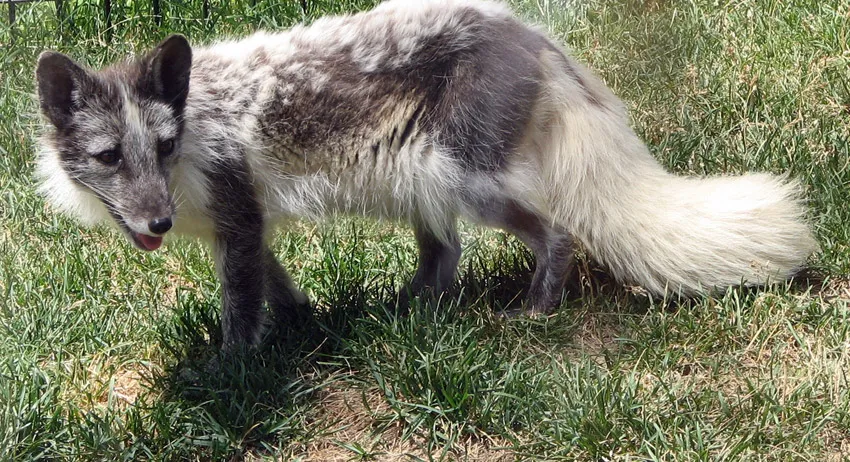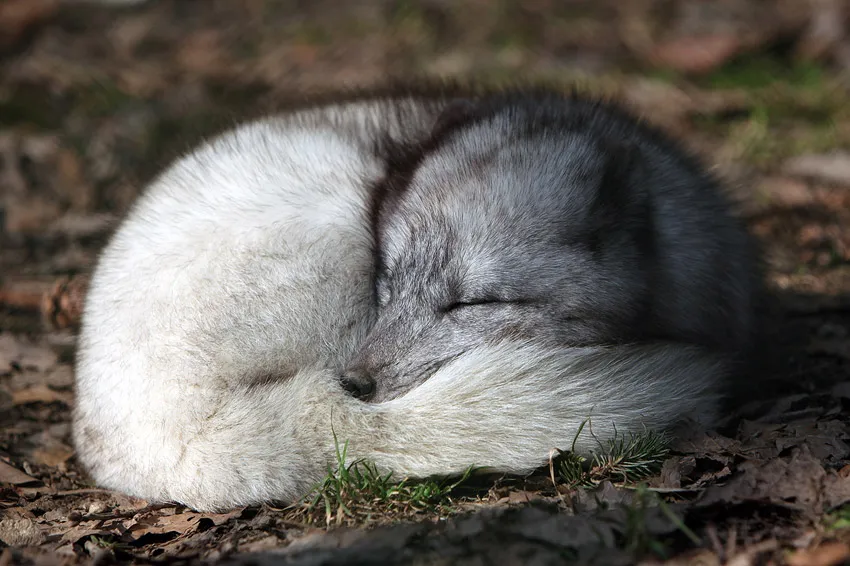Arctic Fox - Facts and Adaptations
Vulpes lagopus
/ Alopex lagopus
Arctic foxes (also sometimes called the polar fox, white fox or snow fox) are true animals of the far north, they live their whole lives above the northern tree line in the Arctic tundra.
arctic foxes facts - Basics
Average Weight: 3 to 8kg (6.5-17 lbs)
Average Length: 75 to 110 cm long (2.3-3.5
feet) including a tail of around 30cm (12 inches), 20 to
30cm (9-12 inches) tall at the shoulder, females slightly
smaller than males
Breeding Season:
Arctic foxes form monogamous pairs through a breeding season
(April to May) though often several females will live together
in a large and complex den that can be many years old, even
centuries. Typically they have litters of 5 to 8 but may
be as many as 25, the most of any carnivore. Sometimes young
non-breeding foxes will live in the den too and help to
raise the pups from the following year.
Estimated
world population: - Several hundred thousand, wide
fluctuations as a result of varying prey numbers and a rapid
ability to reproduce.
Diet: A wide
range of foods, the main prey is lemmings, they will hunt
and catch other small animals and will also scavenge food
from beneath sea-bird colonies on cliffs and left overs
from predators such as polar bears. They will take eggs
where possible from tundra nesting birds, though are not
entirely carnivorous also eating berries and seaweed when
available.
A family of foxes can get through several
dozen lemmings in a day. They will eat young ringed seals
when they are vulnerable in the snow den shortly after they
are born in the same manner that they attack lemmings beneath
the snow, detecting them by sound and then jumping on and
punching through the covering snow layer.
Conservation status: Least Concern.
Habitat and Distribution: The Arctic
Fox lives its whole life above the northern tree line in
the Arctic tundra, it has found its way to most Arctic islands
and is the only mammal native to Iceland. It may be found
on the sea-ice in winter as it extends its foraging range.
The southern limit of the arctic fox is partially dictated
by the presence of red foxes which out-compete arctic foxes
in areas where tundra turns to shrubs and trees.
Predators: Polar bears, wolverines, red
foxes and golden eagles. They have been and continue to
be trapped for their thick winter coats in particular.

Distribution range of the Arctic Fox
What are Arctic Foxes like? What adaptations do they have?
They survive in some of the coldest places on earth which is no mean feat for such a relatively small animal, they have a number of anatomical, behavioural and physiological adaptations that allow them to do this successfully.
Arctic Fox Adaptations:
- Relatively low surface area to volume ratio
(anatomical) - Compared to other species of fox,
arctic foxes have proportionally shorter legs, shorter necks
and smaller ears. This means that there is less surface
area to lose heat from compared to more slender southern
foxes.
- Thick camouflaged seasonal fur (anatomical)
- The coat of the arctic fox is always thick and highly
insulating. They grow two rather distinct versions over
the course of a year however. The summer coat is thinner
and dark grey to a brown, the colour allowing it to be camouflaged
against the darker background of rock and vegetation when
the ice and snow of winter have melted. The luxurious winter
coat is very thick making the fox look more rounded and
is white so camouflaging it against an icy background.
-
Thick fur on the tail
(anatomical) - The tail acts to provide extra insulation
when it is needed. When the fox is active and generating
heat it is out of the way, while when the fox curls up to
sleep or to keep warm in extreme cold, the tail fur can
brought into play for extra wrap around insulation.
- Thick fur on the paws (anatomical)
- to insulate them from snow and ice and also provide for
grip on slippery surfaces.
- Thick layer of body fat (anatomical
/ physiological) - for insulation and food storage to help
survive the winter when food supply may be intermittent.
- Countercurrent heat exchanger in the paws
(anatomical/physiological) - Along with many other animals
including domestic dogs, there is a mechanism in the paws
of arctic foxes that keeps them at a lower temperature than
the body core so minimizing heat loss via this extremity
that is in contact with the ground. Blood entering the paws
is used to heat up blood that is leaving, this prevents
the core from being cooled by heat loss at the extremities.
Similar mechanisms are also found in the feet of birds such
as ducks and penguins.
-
 Shelter
in burrows they dig into the snow during blizzards and very
cold weather (behavioral) - A relatively quick
and easy way of avoiding the worst of the weather by tunneling
beneath the snow to avoid the biting wind and gain extra
insulation from the snow. While the temperature in the snow
hole is still below freezing, it can be much higher than
outside the snow hole.
Shelter
in burrows they dig into the snow during blizzards and very
cold weather (behavioral) - A relatively quick
and easy way of avoiding the worst of the weather by tunneling
beneath the snow to avoid the biting wind and gain extra
insulation from the snow. While the temperature in the snow
hole is still below freezing, it can be much higher than
outside the snow hole. - Large litter sizes in years with high prey populations
(physiological) - The population size of arctic foxes is
tied very closely to the population size of its prey which
consists largely of lemmings. Lemmings can breed very quickly
in good conditions though are short-lived, the ability of
the arctic fox to keep up with their reproductive rate to
some degree gives them the ability to take advantage of
productive years before it is too late. Typically an arctic
fox will have between 5 and 9 pups, but have been recorded
as high as 25, the most for any carnivore.
- Very keen sense of hearing (anatomical/physiological) - Though small, the ears of arctic foxes are pointed forwards and so are very directional. They can hear their main prey, lemmings, moving through tunnels they make in the snow allowing the fox to pounce on the area where the sound is coming from without needing to see the prey and with the prey unaware that the fox is about to pounce.
Arctic Fox Raids Polar Bear Kill, video 2 mins 32 secs - National Geographic
Creative Commons Attribution 2.0 license - Curled sleeping - Rama
Creative Commons Attribution 3.0 license - White winter coat - Algkalv | Summer coat on rocks - Michael Haferkamp



